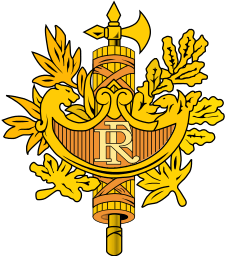France–Italy relations
 |
|
France |
Italy |
|---|---|
France–Italy relations refer to the interstate relations as well as the historical links between the Republic of France and the Republic of Italy (since 1946) and its predecessor the Kingdom of Italy (1861—1946). Both countries were among the Inner six that founded the European Community, the predecessor of the EU. They are also founding members of the G7/G8 and NATO. Since April 9, 1956 Rome and Paris are exclusively and reciprocally twinned with each other:
- (French) Seule Paris est digne de Rome; seule Rome est digne de Paris.
- (Italian) Solo Parigi è degna di Roma; solo Roma è degna di Parigi.
- "Only Paris is worthy of Rome; only Rome is worthy of Paris."[1][2]
Border
The two countries share 488 km of border[3] The border is mostly that determined in 1860 in the Treaty of Turin. The kingdom of France had shared a border with the Duchy of Savoy since the incorporation of Provence into France under Charles VIII in 1486. The wider French-Italian border region had been part of the Kingdom of Arelat during the 11th to 14th centuries.
The border between the France and Savoy had remained in flux since the Italian Wars. In the early modern period, it was fixed in the Treaty of Turin of 1686. After the War of the Spanish Succession, the House of Savoy made large territorial gains, becoming the 18th-century nucleus for the later Italian unification. Savoy was occupied by revolutionary France from 1792 to 1815. Savoy, along with Piedmont and Nice, was conjoined into the Kingdom of Sardinia at the Congress of Vienna in 1815,[4] In 1860, under the terms of the Treaty of Turin, Savoie and Nice was annexed by France, while Piedmont and the Aosta Valley passed to Italy. The last Duke of Savoy, Victor Emmanuel II, became King of Italy.
There remains a territorial dispute over the ownership of the Mont Blanc summit, the highest mountain in Western Europe.
Economy
France is Italy's second largest trading partner and, symmetrically, Italy is also the second-largest trading partner of France.[5]
Intercultural influences
Italian culture in France
Italian Renaissance had a great influence on France during the 16th century.
Two queens of France, Caterina de Medici and Maria de Medici, and a chief minister of France, Giulio Mazzarino, were Italians. As well, the House of Savoy, who ruled Italy from 1861 to 1946, had French origins, from the historical Savoy region.
Many Italian immigrated to France during the first part of the 20th century: in 1911, 36% of foreigners living in France were Italian.[6] Immigrants have sometime suffered a violent anti-Italianism like the Vêpres marseillaises (Marseilles vespers) on June 1881 or Aigues-Mortes massacre on 17 August 1893.[7] Today, it is estimated that as many as 5 million French nationals have Italian ancestry going back three generations.[8]
Nowadays 340,000 Italian nationals live in France,[9] while 130,000 French citizens live in Italy. In the French Departement of Alpes-Maritimes at least 80% of the population can trace some ancestry back to Italy and 40% can claim it as solely Italian and Italian is the mother language of 30% of the population. In Corsica the local culture is more Italian than French.
French culture in Italy
Villa Medici host the French Academy in Rome which is responsible for promoting French culture in Italy.
Institutions
Both France and Italy are founder members of the European Union and adopted the euro from its introduction.
Since 1982 an annual summit formalize French-Italian cooperation in Villa Madama.[10]
Military
The Prime minister of the Kingdom of Sardinia Camillo Benso was able to take Napoleon III on his side after the Orsini affair during the Italian Unification: The French army was allied with Victor Emmanuel II of Italy during the Second Italian War of Independence and at the Battle of Solferino. After that, France opposed Italy during the Capture of Rome, that represented the end of the Papal temporal power.
After World War I the governments of the two countries were both among the big four that defeated the Central Powers.
The last military conflict was the Italian invasion of France in June 1940.
Sport
- France-Italy football rivalry is one of the most famous sport rivalries worldwide.
- The Giuseppe Garibaldi Trophy is a trophy for the winner of the Six Nations match between France and Italy in rugby union.
See also
- Hôtel de Boisgelin : Italian embassy in France
- Palazzo Farnese : French embassy in Italy.
Notes and references
- ↑ "Twinning with Rome". Retrieved 27 May 2010.
- ↑ "Les pactes d'amitié et de coopération". Mairie de Paris. Retrieved 14 October 2007.
- ↑ https://www.cia.gov/library/publications/the-world-factbook/fields/2096.html
- ↑ Wells, H. G., Raymond Postgate, and G. P. Wells. The Outline of History, Being a Plain History of Life and Mankind. Garden City, NY: Doubleday, 1956. p. 723–753.
- ↑ http://www.diplomatie.gouv.fr/en/country-files/italy/france-and-italy/economic-relations-6993/
- ↑ Corti, Paola (2003), L'emigrazione italiana in Francia: un fenomeno di lunga durata, Altreitalie, Template:Numéro26, janvier-juin 2003
- ↑ L'immigration italienne en Provence au XIXe siècle
- ↑ Cohen, Robin (1995). Cambridge Survey. Books.google.com. ISBN 978-0-521-44405-7. Retrieved 2009-05-11.
- ↑ http://www.insee.fr/fr/themes/document.asp?ref_id=ip1098®_id=0&page=graph#graphique1
- ↑ http://www.diplomatie.gouv.fr/en/country-files/italy/france-and-italy/political-relations-6992/
| ||||||||||||||||||||||||||||||||||||
| ||||||||||||||||||||||||||||||||||||||

